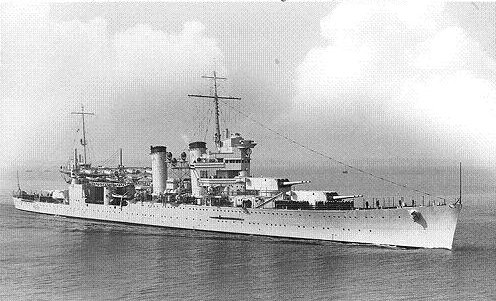![]() The Pacific War Online Encyclopedia
The Pacific War Online Encyclopedia
|
| Previous: Heavy Bombers | Table of Contents | Next: Hedgehog |

Naval Historical Center #71787
Heavy cruisers were a creature of the naval disarmament
treaties. Up to the
end of the First World War, cruisers
served as
scouts for the main battle
fleet, as commerce raiders or escorts, and
to show
the flag in distant colonies. For these roles, 6” (152mm) or
smaller guns
were
perfectly adequate, and this was the standard cruiser armament.
However,
the British had experimented with 7.5" (190mm) guns on the Hawkins
class, and so the Washington Treaty of 1922 limited non-capital ship gun
caliber to 8” (203mm). This immediately became a new standard for
cruiser armament. Under the London Treaty of 1930, ships
whose
guns met the older standard of 6” caliber became known as light cruisers,
and those with
the newer 8”
standard caliber became known as heavy cruisers. The Japanese referred
to them as "C" and "A" cruisers, respectively, while making a
distinction between these types and the Mogamis or "B" class cruisers, which were initially heavily armed with 6" guns but were later converted to 8" gun cruisers.
The U.S. Navy switched from 6" to 8" main armament with remarkably little debate, only to find that providing adequate protection on a
10,000 ton ship armed with 8" guns was problematic. The Bureau of
Ordnance preferred the 6" gun, believing that the 8" gun "has always
been sort of a mongrel type; it is not heavy enough to effective against
an armored ship and has not been light enough to get much rapidity of
fire" (quoted by Friedman 1984). However, the General Board still
strongly supported the 8" gun. Ultimately, the debate within the U.S.
Navy was settled by diplomatic developments. The Royal Navy had never developed much enthusiasm for the 8" cruiser concept, believing that a
larger number of smaller cruisers better served British interests. The
London Treaty of 1930 therefore limited the United States to 18 heavy
cruisers, Britain to 15 heavy cruisers, and Japan to 12 heavy cruisers.
Both the United States and Britain subsequently switched back to an
emphasis on light cruisers in their construction programs.
Because heavy cruisers were both more numerous and more expendable than capital ships, they were often the backbone of surface forces in restricted or distant waters. For example, heavy cruisers were central to many of the surface actions of the Guadalcanal campaign. When battleships were committed by either side, the heavy cruisers continued to fight alongside them, at considerable cost to themselves.
References
The Pacific War Online Encyclopedia © 2007, 2009, 2013-2014 by Kent G. Budge. Index